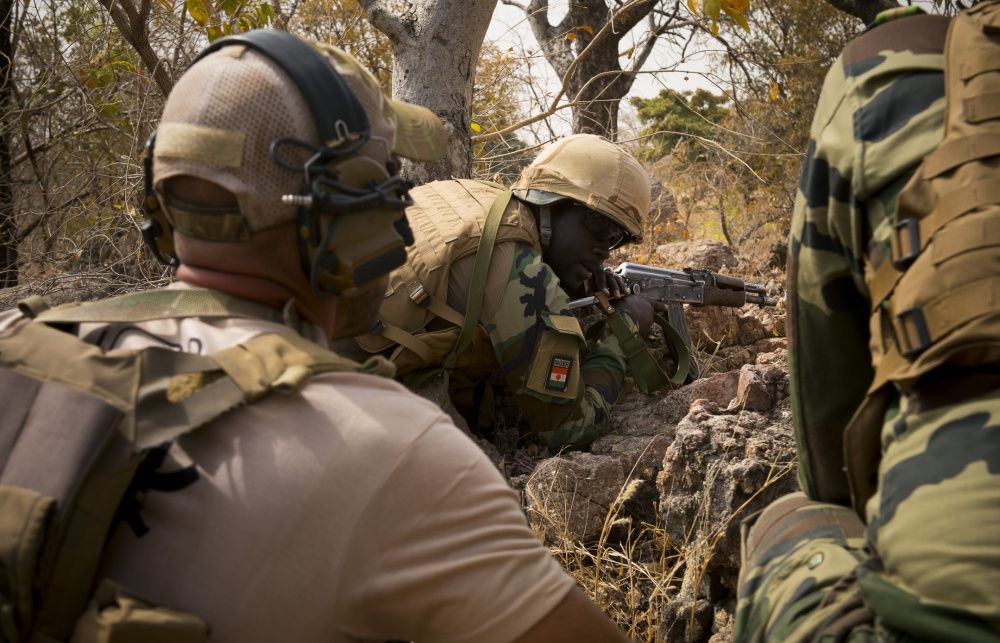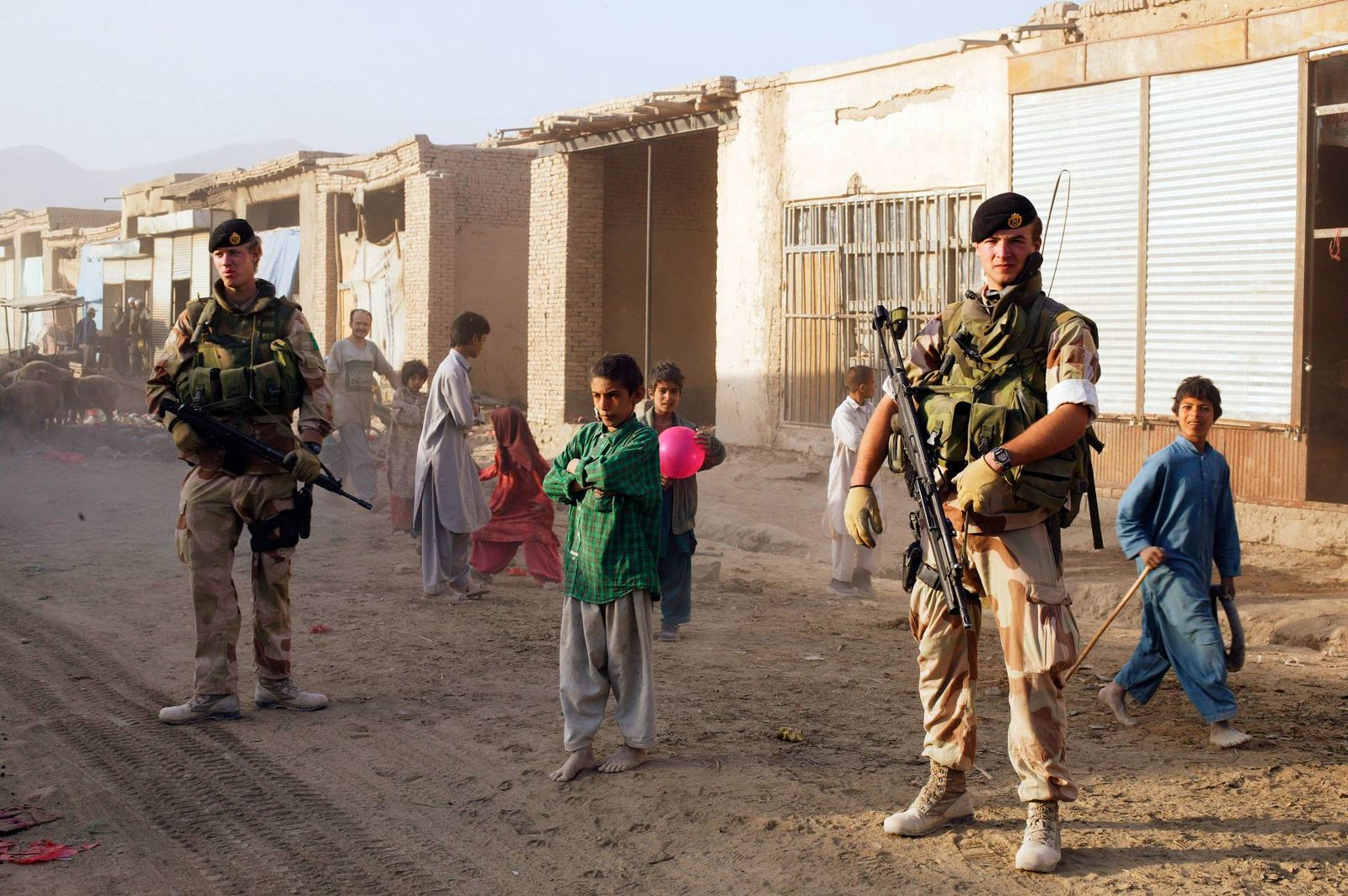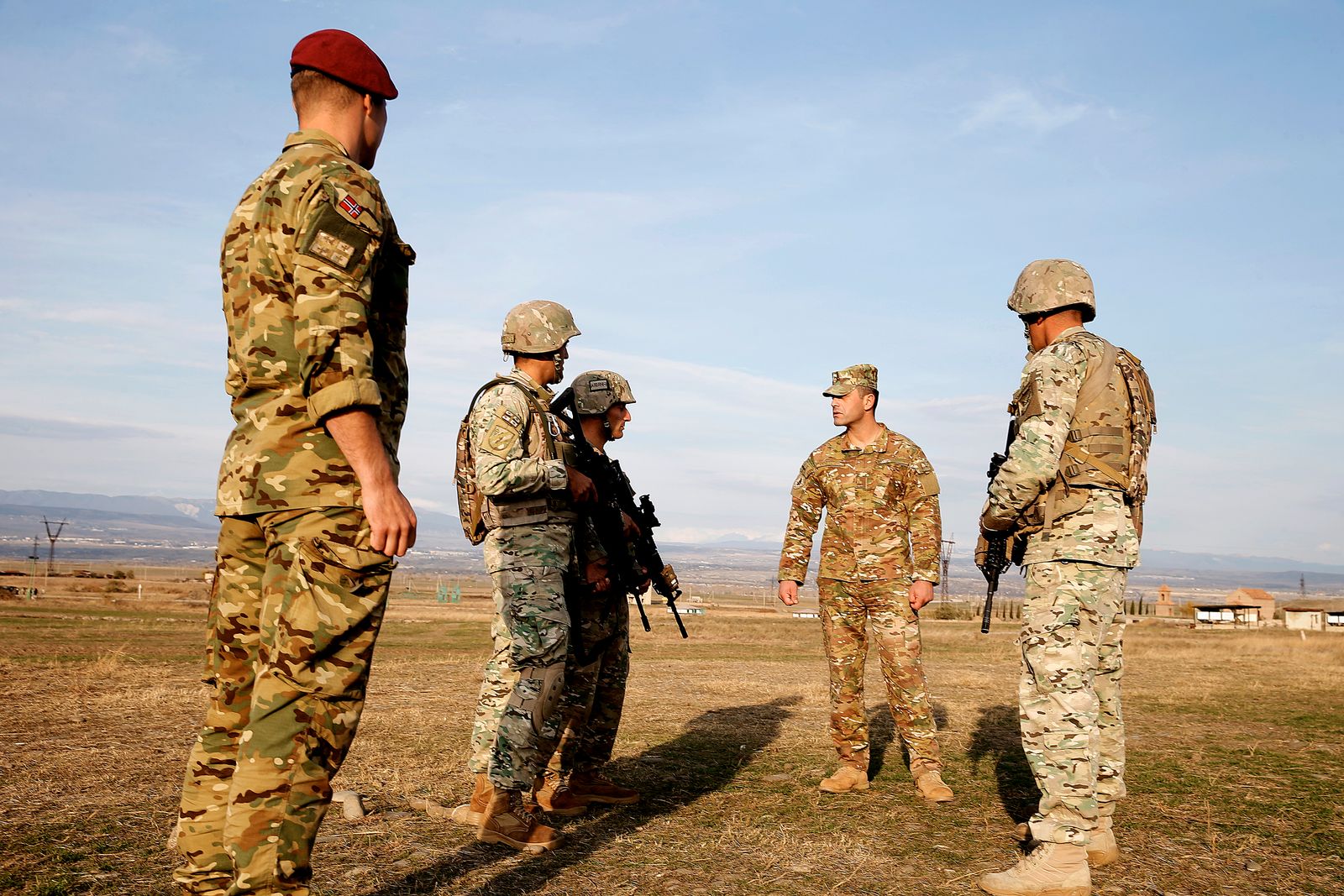Small states can punch above own weight
For small states with limited military capabilities, such as Norway, it is important to prioritize how we utilize our capabilities in order to generate intended strategic effects. Norway cannot contribute and/or prepare for everything, we must choose. And, in some respects we already have – whether it is intended or not – subsets of Security Sector Assistance (SSA) has become a preferred option for us to create short- and long-term strategic effects.
The logic is simple; contributing to coalitions and collective security efforts is seen as burden-sharing – thus strengthening relations pivotal to own security.[1] In the Norwegian narrative, international operations are also construed as contributions to a global interdependent security; creating a secure environment there will strengthen security at home. It follows that their ability to sustain a stable security environment creates predictability for us– making SSA “the logical choice”. SSA also promise a better cost-gain ratio than normally associated with military operations, making it more attractive for both politicians and the public. SSA seems like the recipe for success for small states trying to leverage their limited capabilities.
However, if we should be so daring as to actively choose to focus at least some of our national efforts on SSA, we believe that we must make four acknowledgments, in order to achieve the highest yields of our efforts. SSA can indeed create strategic effects, and small states can punch above own weight – but only if we fight smart and pick the right fights.
We have witnessed and experienced some of the dynamics the different activities within the overarching SSA-framework represent. For small nations, or at least for Norway, SSA cannot entail all the different military activities large nations – i.e. the U.S. – are able to offer as strategic options.
This fact, that small states have a different spectrum of military activities available for SSA, is the first acknowledgement. In continuation of this it is also of utmost importance to educate both the political decision makers and the military organization and its leadership about the actual utility of the spectrum. This is because without knowing what the different activities represent, it is challenging to generate intended effects. And, furthermore, without knowing what is inside the box, it is quite challenging to intentionally be creative and think outside the box.
The utility of available options is also closely intertwined with the actors to perform the deeds. Conventional/general purpose forces, SOF, intelligence agencies, police, civilians/contractors – all have different specialties that are better suited to meet the requirements of some activities than others. The reason for pointing this out is because it is with these issues as with many other things in life; we like to get things that matter done right the first time! We do not (usually) send our kids to a veterinarian when they get sick, and most do not use a blacksmith to fix expensive Swiss wristwatches. If these are the only options, one might decide it is better than no action – but we should not make such choices out of ignorance or a lack of appreciation of the dynamics at play. One should also keep in mind that the strategic utility of SSA-effort is highly dependent on the perceived success with partners and at home.[2]
Our experience in combination with our research within the field tells us that it is important to define the spectrum in order to; first, counter what some think is a pure military privilege – to define military end states; second, generate a better understanding of how strategic utility can be achieved through intelligent SSA. We are sure that both the military – who correctly does not treat SSA as their first priority – and decision makers – who have a lot more than military matters to think of on a daily basis – would benefit from a much better understanding of the spectrum and what distinct military options exist. This should enable a more informed “unequal dialogue” between military commanders and the political level.[3]
A Norwegian doctrinal framework for this does not exist, and this is perhaps one of the reasons the discussion on SSA is so hard to tie down. We often allow ourselves to discuss specificities with anecdotal empirical data, rather than principles and premises. There is an obvious need for a national doctrine on SSA, and what better place to start than with the spectrum of SSA-activities viable for a small state.

For Norway the spectrum of SSA efforts should be defined as:
- Unconventional Warfare
- Military Assistance
- Security Force Assistance
- Security Sector Reform
From a small state perspective, it might seem borderline irrelevant to focus on issues that for some might seem as little more than semantics. And, it might be challenging to generate heartfelt appreciation for these themes, since small states at best are only another cog in the wheel. It nonetheless becomes irrefutably relevant when participating in larger SSA-efforts or conduct strategic level efforts on a smaller scale. Constructing a coherent roadmap stating how the military component’s clearly defined efforts and objectives supports the overall aims requires at least a rudimentary level of insight. Without the basic knowledge, any actor might end up supporting a system they do not understand, or take actions that do not support the system – becoming irrelevant to the actual outcome of the operation. This is a question of picking the right fights.
Especially when SSA-contributions might seem numerical minuscule, it is key to not only understand the system – but also the particulars of the different indirect efforts and activities at the operational and tactical level. As noted above, it is only through an appreciation at this level of detail that strategic decisionmakers can ensure the correct employment of the correct “tool”, and how to wield it. As already noted, our assessment is that there are four different activities that are particularly relevant for small states to distinguish between in the context of SSA; Unconventional Warfare (UW), Military Assistance (MA),[4] Security Force Assistance (SFA),[5] and, Security Sector Reform (SSR).[6] To elaborate and be more precise in how these activities can be understood, we would like to present the following descriptions;
Unconventional Warfare is an activity that only the U.S. has as an official doctrine for, although several other states conduct these types of operations. UW is defined as: "operations and activities that are conducted to enable a resistance movement or insurgency to coerce, disrupt, or overthrow a government or occupying power by operating through or with an underground, auxiliary, and guerrilla force in a denied area." [7]It is an activity that is exclusively conducted by SOF, or elements within intelligence agencies. This does not exclude others to contribute, but it is SOF or an intelligence agency that has oversight, command and control. UW is potentially more relevant in other strategic efforts, like counterinsurgency, but it clearly has relevance in some SSA-efforts as well. In SSA, UW is mainly relevant when you have a situation where democratically controlled security forces do not exist, or if one wants to include/incorporate militias, paramilitaries or other powerbrokers into the security forces.
Military Assistance is also an activity that is exclusively conducted by SOF. Meaning; having oversight, command and control. It is by NATO defined as: "a broad category of measures and activities that support and influence critical friendly assets through organizing training, advising, mentoring, or the conduct of combined operations. The range of MA includes, but is not limited to, capability building of friendly security forces, engagement with local, regional, and national leadership or organizations, and civic actions supporting and influencing the local population. SOF conducts MA within their field of expertise." [8] This activity often leads to SOF assisting host nation SOF, but if the situation demands it, for example if the assistance involve an elevated political risk, SOF can also give assistance to conventional forces – in such cases it is often framed as Foreign Internal Defense (FID) by the U.S. or SFA by NATO.
Security Force Assistance is an activity that can be conducted by conventional/general purpose forces, specialized conventional forces or SOF. For all practical purposes this is assistance to the conventional security forces in a host nation. This is potentially the broadest category of activities for the military component to independently oversee, command and control wise, since it encompasses an extremely wide range of assistance efforts. Ranging from supporting basic marksmanship at the tactical level, through military leadership education at the operational level, to establishing understanding of the importance of joint- and multi domain synergy in headquarters at the military strategic level. The scope involved in this activity, and the resources necessary to see it through, means it should be under conventional forces’ command and control.
Security Sector Reform is an activity that can be conducted by civilians, conventional/general purpose forces or SOF. SSR is defined by NATO as: "a comprehensive set of programs and activities undertaken to improve the way a host nation (HN) provides safety, security and justice. SSR is a longterm effort conducted by the HN government requiring extensive resources and participation of many security sector actors. NATO contributes to the HN’s SSR through security sector assistance, which refers to the activities of NATO members and forces to engage with foreign partners to help shape their policies and actions and build and sustain HN capacity and effectiveness in the security sector." [9] This activity clearly includes more than the military component. It necessitates "Interagency", and it requires a more stable environment to be effective compared to the other "activities;" MA and SFA in particular, which often might be a subset of SSR. This, in combination with democratic values – which we assume is something an SSR-effort is expected to promote to the host nation – is why SSR should be civilian led.

The magic and the beauty of Strategy
Looping back to the perceived lack of appreciation for the spectrum; Expecting individual decision makers at the operational and strategical level in solitude to fill the role of military genius is as morally reprehensible as expecting tactical battlefield brilliance to save a flawed strategy. That is why we think that the second acknowledgement should be to embrace strategy at all levels, and one should seek to educate oneself, in order to understand the importance of balance between ends ways and means. This is the only way one can ensure coherency between all levels of own effort, and ensure purposeful efforts aiming to achieve the defined strategic objectives of SSA-commitment.
Let`s be honest, small states seldom determine the overall endsof SSA-efforts. Neither do they design the campaign plans – the ways. They simply pitch in with means. However, due to the interdependence of ends, ways and means, small states can still influence the higher order factors through niche-capabilities or insights that affect the way one can operate, or even the ends that can be achieved. Arguably, the strategic utility of own efforts increases as it influences higher levels of this hierarchy – creating increased political dividends. It follows that (small) states should be conscious how they contribute, and with what. And, furthermore, national SSA-contributions must be aware of these dynamics in order to ensure actual utility of own efforts. When, where, how and with whom actions are taken, and how this is communicated, directly influences achievement of national objectives; the same action may have completely different effects pending the actors strategic understanding.
Norway, it seems, lack a systematic appreciation of these dynamics. Despite an impressive number of SSA operations the last decades, there are no relevant doctrines or guidelines in place.[10]What little exists is anecdotal and more descriptions of previous practice than guidance for future SSA operations.[11]Missing is also a clarification of “division of labor” and interdependence between SOF and conventional forces in SSA. Lacking doctrinal guidance and clarity, contributions are seldom built-for-purpose, and it is not uncommon for military components to conduct activities they “want to” rather than what they logically should. The strategic utility of such efforts is limited, at best.
Exploiting the strategic utility of SSA – Small states as strategic enablers:
In order to exploit the strategic utility of SSA for small states it is relevant to identify if your military may offer one or more niche capabilities. This is the third acknowledgment. If it is possible to pinpoint a niche that few or no-one else can offer – your military might end up as a strategic enabler. This allows what may be minuscule numerical contributions to affect higher order factors of the strategy, allowing small states to punch above own weight through fighting smart.
Professor Anna Simons supports this line of thought, outlining how some members within NATO SOF should look to offer NATO specialized and specific expeditionary MA-capabilities instead of "classic" expeditionary DA-capabilities, since some NATO members most likely fit that role better than others.[12]A potential future example, and proposed course of action for Norwegian Special Operations Forces is for NORSOF to work as a strategic enabler by conducting Military Assistance in Support of Negotiations, Defense Security Sector Reforms and Disarmament, Demobilization, and Reintegration Processes.[13]A possibility we have yet to capitalize on.
Others have, and we want to point out three relevant operationalized examples: (1) The Belgian Special Operations Forces in Niger[14] – operationalizing their Localization Strategy;[15](2) The Norwegian Special Operations Forces in Georgia – establishing the Joint Training and Evaluation Centre (JTEC) in Georgia,[16]and (3) The Norwegian Special Operations Forces in Afghanistan - working with the Afghan Crises Response Unit (CRU222).[17]All good examples of unique contributions, with plenty strategic utility – although one may not have been able to consciously leverage their full potential.

Challenges in SSA for small states – The solution is Vertical implemented Assistance
In SSA-efforts there are always conglomerates of interests at play, that can make it difficult to attain own strategic objectives without challenging others’ agenda. There is always “[…] an inside the family story, and […] an outside the family story."[18]In its simplest form, there is a story for the Host Nation (HN) – and one for “us”. But the conjugal family analogy is not in tune with modern family compositions; “the other family”, “yours” and “mine” are commonplace – also in a more figuratively sense. Most modern operations depend on a multitude of contributors; [19]even the U.S. “[…] has not launched a major military operation since the Second World War without attempting to establish a working coalition or an alliance […]”.[20]This is a paradox of modern operations; we need coalitions, but coalitions are militarily ineffective.[21]Within coalitions there are many “family compositions” with associated “stories” and privileged information – representing diverging motives. Similarly, HNs seldom have one unified “story”. This disjointedness makes the collective effort less predictable and effective, and hampers fulfillment of own strategic objectives.
First issue, the Principle Agent Problem - HN:
In all scenarios where two parties have diverging aims – although they might not express so publicly – one is faced with what has been coined the “principal-agent-problem”. This problem occurs when “one person (the agent) is allowed to make decisions on behalf of another person (the principal)”, and where “the agent usually has more information than the principal” thus creating a situation of asymmetric information.[22]In the context of SSA it might be simplest to view the contributing state as the agent, acting on behalf of the host nation as a principal – but in some instances the logic might be reversed. The main point here is that the information asymmetry on different issues combined with potentially conflicting goals might lead to situations in which the principal is dissatisfied with the choices made, and might challenge the belief that the agent’s actions are to the best of the principal, thus undermining the trust necessary for fruitful cooperation over time.
Second issue, Access to information – within the Military organization:
The second reason is that information-sharing culture within the advisory organization or coalition is based on strict compartmentalization, and the “need to know" principle. Our perception is that such practices are obsolete in these types of effort; they fit better in high-end type of fights – major combat operations, DA or SR. This does not mean that there is not information that should be guarded/protected and not available for everyone, but we believe – as Stanley McCrystal do – that the principle should be: share until it hurts.[23]Nevertheless, the reality is that information sharing based on the "need to know" principle still often is the preferred way to do business. This is especially pronounced when the effort is conducted within the framework of a coalition including members of the Five Eyes Intelligence Community, consisting of USA, Canada, United Kingdom, Australia and New Zealand.[24]
Vertical implemented SSA – The fourth acknowledgment:
Even though all advisory efforts do not include combat or violence, the Clauzewitzian notion of the fog of war is still applicable. Indeed, one might argue it may even be just as pervasive in the preparation for such efforts.[25]Further, since advisory efforts, by definition, involves a relationship between at least two parties – often more – it may cause friction. Faced with a dynamic situation, wicked problems, and complicated relationships, the only promise one may offer before an SSA-effort is that it will not be a smooth adventure or experience! Yet, we argue that deliberate and purposeful human interactions is one of the keys to make it as efficient and effective as possible.
The planned and intentional efforts in this regard is what we call vertical implementation. This is not the “same as” as taking a classic U.S “holistic approach,” by overwhelming a host nation with personnel at all levels – tactical, operational, military strategic and the political level. A small nation will not have the human resources to do it this way and therefor needs to do this in a smaller scale, and the interactions need to be more “targeted” compared to what large states need to focus on. Small states must identify the key information junctions and decision-making nodes both within the HN and within the overall SSA-effort, and seek to embed themselves there. This ensures access and transparency, but also allows the timely and precise leveraging of own niche capabilities – and ensures the possibility to produce rather than consume the narrative. Both vital points in order to create strategic utility of own efforts.
Conclusion
For small states with limited military capabilities and resources relevant for military efforts, it might -for the untrained eye – seem meaningless to prioritize SSA. The contributions might, after all, be seen as relatively small in comparison to for example the U.S. Others might argue it is irrelevant to generate capabilities and/or prioritize SSA compared to other more “existential” activities. Yet, we argue that if one takes an eagle view on the issue, it should be obvious that the contribution to SSA will have strategic value beyond the specific mission at hand. Smart SSA may very well be the most efficient way to safeguard national interests on several levels.
Even though this is challenging; in some areas Norway are “already there,” but there is still a lot of ground to cover until we can claim victory or success. At the center of the difficulties associated with operationalizing SSA is the question of whether we are ready to accept that this is one of the best and most important ways that small state militaries can contribute to national security – through an indirect approach. If so, we must prepare for the actual challenge and accept that this requires dedication, purposeful application of the resources commitment, and unambiguous guidance from political and military leadership.
By acknowledging that small states got a different spectrum of military SSA-activities compared to large states; by embracing strategy at all levels, in addition to educate oneself and understand the importance of balance between ends ways and means; by small states identifying their unique strategic enabling roles and niche capabilities; and, by focusing on vertically implementation of own SSA-efforts, we firmly believe that it is possible for small states to generate a relative higher strategic utility by focusing on SSA-efforts compared to large states. It is only a question of deciding whether we wish to get the most out of our efforts.
Foto: Belgian SOF i Niger ifm øvelsen Flintlock 2019 i Burkina Faso hvor også norske styrker deltok (Richard Bumgardner / DVIDS)
This article was first published by Small Wars Journal.
[1] Regjeringen. 2018. "NATO Summit: Allied unity and burden-sharing," Government.no,10 JUL 2018 https://www.regjeringen.no/en/aktuelt/nato-summit-allied-unity-and-burden-sharing/id2607134/(accessed 20 NOV 2018)
[2] Knowles, Emily & Watson Abigail. 2018. Lessons Learned in AWQ, ED 2. Oxford Research Group, Remote Warfare Programme, 15.
[3]Elliot A. Cohen, Supreme Command: Soldiers, Statesmen, and Leadership in Wartime, (New York: The Free Press, 2002). Chapter 7
[4]NATO, Allied Joint Doctrine for Special Operations, AJP -3.5, version A, 1st ed. (Brussels, Belgium: NATO Standardization Agency, 2013), 2–1, emphasis added.
[5]Chairman, Joint Chiefs of Staff, Security Force Assistance (Joint Doctrine Note 1–13), 1st ed. (Washington, DC: Chairman, Joint Chiefs of Staff, 2013)
[6]NATO, Allied Joint Doctrine for Security Force Assistance, AJP 3.16, Edition A, version 1. (Brussels, Belgium: NATO Standardization Agency, 2016), VIII,
[7] Chairman, Joint Chiefs of Staff, Special Operations (Joint Publication 3–05)(Washington, DC: Chairman, Joint Chiefs of Staff, 2014), X-I.
[8]NATO, Allied Joint Doctrine for Special Operations, AJP -3.5, version A, 1st ed. (Brussels, Belgium: NATO Standardization Agency, 2013), 2–1.
[9]NATO, Allied Joint Doctrine for Security Force Assistance, AJP 3.16, Edition A, version 1. (Brussels, Belgium: NATO Standardization Agency, 2016), VIII,
[10] Andreas Hedenstrom & Marius Kristiansen, NORSOF Military Assistance Capability Development (Master’s thesis/Capstone project, Naval Postgraduate School, 2016), 44.
[11] Terje Bruøygard, «Telemark bataljon som rådgivningstyrke i kampen mot ISIL,» Norsk Militært Tidsskrift, Nr 2/2018. Oslo: Oslo militære samfund, 2018, 20-29; David Seppola, «Norwegian Task Unit 3 – Når et kompaniteam opererer for å møte Norges strategiske målsetninger i Irak,» Forposten (elektronisk nettutgave), NR.1 2017/MARS;14-17; Forsvarets Overkommando, Joint Doctrine Part B—Operations [Forsvarets Fellesoperative Doktrine del B Operasjoner], 1st ed. Oslo, Norway: Forsvaret, 2000, 204; John Inge Hammersmark, “The Development of Norwegian Special Forces: Symbolic or Functional Utility?” (master’s thesis, Forsvarets stabsskole, 2010), 40.
[12] Anna Simons."'Scalpel' or 'easy button'? Neither - and some further considerations," Conference Proceedings no.4(a), Interdisciplinary Perspectives on Special Operations Forces, Edited by Gitte Højstrup Christensen, Chapter 9. (Royal Danish Defence College: 2017). 168-188. http://fak.dk/publikationer/Documents/Conference%20Proceedings%20No%204%20(a)%202017%20NET.pdf (accessed 10 OCT 2018)
[13] Andreas Hedenstrøm and Marius Kristiansen, Military Assistance in Support of Negotiations, Defense Security Sector Reforms and Disarmament, Demobilization, and Reintegration Processes, http://smallwarsjournal.com/jrnl/art/military-assistance-in-support-of-negotiations-defense-security-sector-reforms-and-disarmam
[14] Wilèn, Nina. Africa Policy Brief No.26 May 2019: “Belgian Special Forces in the Sahel: A Minimal Footprint with Maximal Output?” Egmont Institute 2019. http://www.egmontinstitute.be/content/uploads/2019/05/apb26.pdf?type=pdf
[15] Dehaene, Pierre. “The Localization Strategy: Strategic Sense for Special Operations Forces in Niger.” CTX Volum 9, No.1 2019. http://liferayce3.globalecco.org/documents/35547/40800/CTX+Vol.+9.+Issue+1.pdf/8a7c4b1f-3c2b-4bee-9e7a-3a00ab72a74d?t=1552506101277
[16] Ole Christian Emaus (Initial JTEC Advisor Team Commander), in conversations with the author, 15 OCT, 2018
[17] Tor Jørgen Melien, Våre hemmelige soldater. Norske spesialstyrker 1940-2012, Oslo: Spartacus, 2012.
[18] Mara E. Karlin, "Rethinking Seurity force Assistance in the Middle East," in seminar, the Washington Institute, 23 MAR 2018, https://www.washingtoninstitute.org/policy-analysis/view/rethinking-security-force-assistance-in-the-middle-east(accessed 10 OCT 2019)
[19]Hanssen, Coalition Strategy in Complex Conflicts: The Strategic Behaviour of Three NATO-States in Afghanistan 2003-2008, 20
[20]Hanssen, Coalition Strategy in Complex Conflicts: The Strategic Behaviour of Three NATO-States in Afghanistan 2003-2008, 19
[21]Hanssen, Coalition Strategy in Complex Conflicts: The Strategic Behaviour of Three NATO-States in Afghanistan 2003-2008, 21
[22]See e.g. Prateek Agarwal, "The Principal Agent Problem," The intelligent economist, 8 JAN 2018, https://www.intelligenteconomist.com/principal-agent-problem/(accessed 20 NOV 2018)
[23] Stanley A. McChrystal, My share of the task: A memoir, Portfolio, 2014; Stanley A. McChrystal, "The military case of sharing knowledge," TED-talk/TED2014, https://www.ted.com/talks/stanley_mcchrystal_the_military_case_for_sharing_knowledge (accessed 10 OCT 2018)
[24]Cox, James, “Canada and the Five Eyes Intelligence Community,” Canadian Defence and Foreign Affairs Institute, Desember 2012, 4-5.
[25]Talbot C. Imlay and Monica Duffy Toft, The Fog of Peace and War Planning: Military and Strategic Planning under Uncertainty. New York: Routledge, 2006.









